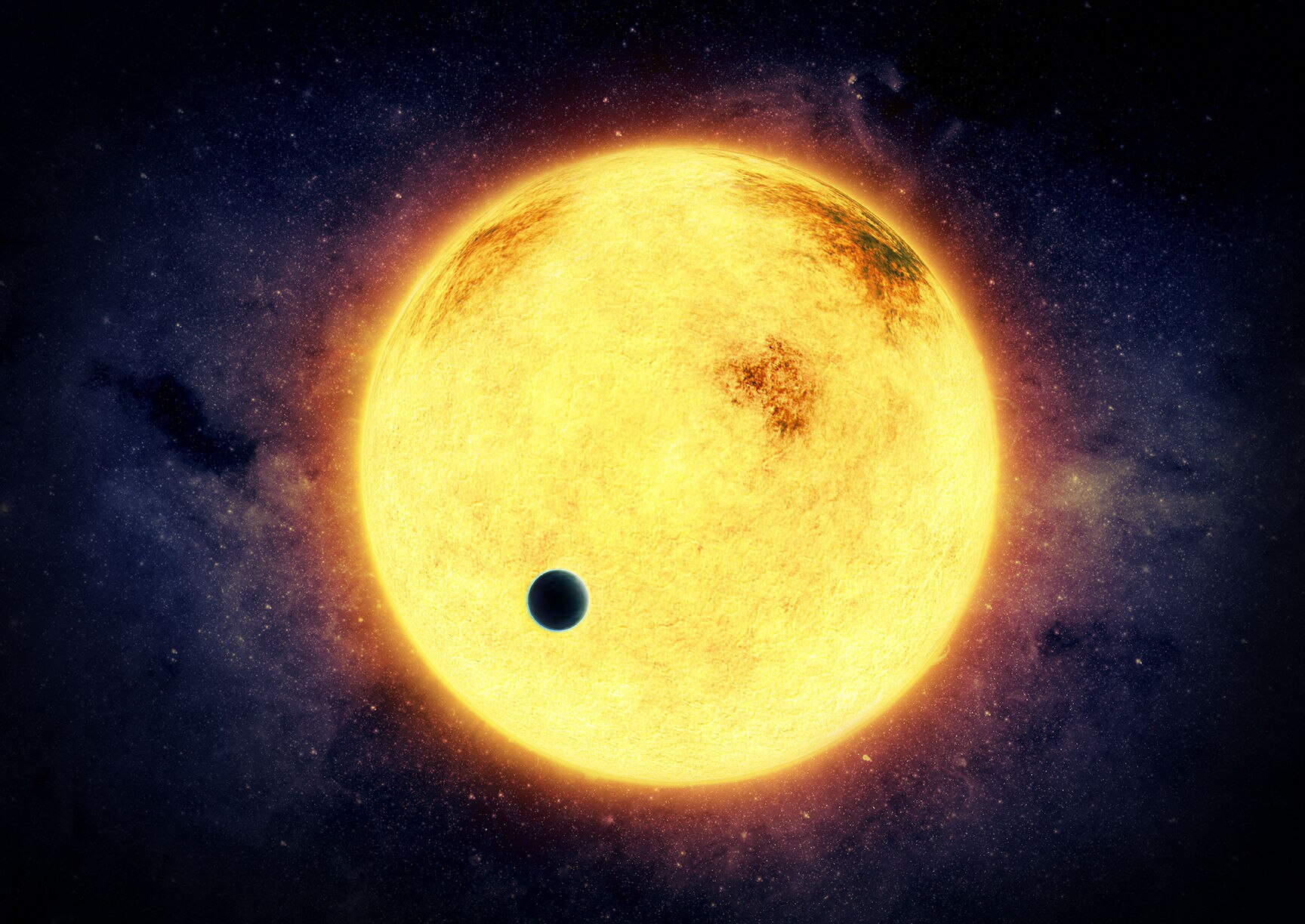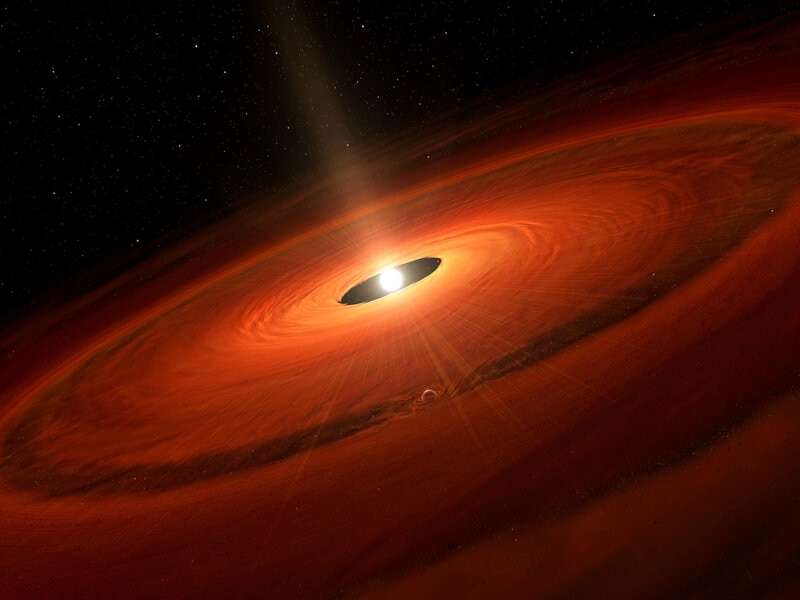Create a free profile to get unlimited access to exclusive videos, sweepstakes, and more!
Can there be a well-behaved infant on a plane? Difficulty: Not an airplane. Also, it's an exoplanet.

Speaking of binary stars and exoplanets and orbital planes...
When I was a toddler, I was a major pain to my parents. I won't go into details but my behavior was not always, um, to my parent's liking.
Instead of a human I should've been an exoplanet. I would've fit right in.
A lot of very young exoplanets have behavioral problems. Unlike our solar system, where the planets all tend to orbit the Sun in the same plane (if you looked at our system edge-on, the planets' orbits would all nearly align) — the plane of the Sun's equator — in quite a few young planetary systems around other stars the planets orbit every which-way. Some are highly tilted to their stars' equators, some orbit over the poles, and some even orbit backwards. It's like a kindergarten class where all the kids have been given coffee and roller skates.
So when a young planet is found that orbits very close to its star's equator, that's something of a big deal. Especially if there's a second star out there tugging at it.
Enter DS Tucanae Ab. This exoplanet was discovered in TESS data in 2019, orbiting a very Sun-like host star about 140 light years from Earth. The star is part of a loose cluster of stars called the Argus Association, which is important: Those stars have been identified to be young, between 30 and 50 million years old. The best guess for DS Tuc (the name of the star the exoplanet orbits) is that its about 40 million years old. That's young — the Sun is literally a hundred times older — and that means the planet is young as well.
DS Tuc Ab is about six times bigger than Earth, or half the diameter of Jupiter. That makes it roughly Neptune-sized, and it hugs its star closely, orbiting only 12 million kilometers from it, giving it a "year" of just a little over 8 days. That also makes this planet quite toasty, with a cloud-top temperature of something like 600° C. Not a place you'd want to hang out.
Except it's oddly well behaved. New observations of this planet indicate its orbit is almost exactly aligned with the star's equator. Two papers were just published on this; one gave its tilt as just 2.5° (based on three transit observations), and the other had a larger uncertainty but similar measurement of 12° ±13° (based on one transit).
And that's a bit weird. DS Tuc the star is a binary system with a somewhat less massive and cooler companion orbiting it some 35 billion or so kilometers away (the Sun-like star is called DS Tuc A, the companion star DS Tuc B, and the planet DS Tuc Ab). That's a fair hike, but close enough that the second star could affect the orbit of the planet. Especially in such a young system…
Stars and planets form from a disk of material, with the star forming in the center and the planet farther out. If you get multiple planets, then they tend to all have the same orbital tilt for that reason. However, in many young systems there are all sorts of issues that can wreak havoc on the disk. A second star orbiting off-plane can yank at those planets, changing their orbits, for example. Or the planets themselves can interact, sending them off in different directions.
In fact it can be difficult to form a Neptune-sized planet as close to its star as DS Tuc Ab, so it may have formed farther out and been dropped in closer. Again that makes it pretty interesting that it orbits so close to its star's equator.
This result can inform our understanding of how planets form and what happens to them after. It shows that sometime things are pretty calm. Likely this planet formed farther out and as it plowed through the disc of stuff it fell toward the star. That implies the second star orbits in the same plane, since if it were off-plane it would've tugged on the planet.
I'm also fascinated by how this was all figured out, too. The star is a mere unresolved dot in the biggest telescopes on Earth, and the planet a fraction even of that. We literally cannot see how this planet moves, so how was its orbital tilt determined?
We see this system edge-on, so once every orbit the planet transits the star, passing directly in front of the star's face like a mini-eclipse. This is how most exoplanets are found, in fact.
But in this case the star also rotates very rapidly. That's common for young stars; they slow as they age due as their magnetic fields interact with material around them, slowing them via drag (the magnetic field acts like a parachute attached to the star, applying a force that slows it over time). From our point of view as the star rotates, one side of it is approaching us and the other side is receding.
That gives the light from the star a measurable Doppler shift. We see the approaching side blueshifted and the receding side redshifted. As the planet starts to transit, at first it blocks the blueshifted side, then eventually moves over to the redshifted side during the second half of the transit. If spectra are taken, this effect, called the Rossiter-McLaughlin effect, can be measured!
By precisely measuring just how the light from the star is affected this way, the angle of the planet's orbit can be determined. In theory, at least… in practice it's harder. DS Tuc A has starspots, like sunspots, but in its case they're very large (again this is common in young stars). Observations over short times show its brightness varying by 2% due to these spots, which is much larger than the planetary transit effect (over very long times the star's brightness varies by 30%). The astronomers had to simultaneously model how these starspots affected the light as well as the planet during a transit, a feat that hasn't been done before for a planet this young.
Needless to say, I love all this. It's amazing that we find planets at all, let alone that we can figure out so much about them. And even better, as we analyze loads of them we see trends, and can start to understand them in general, and not just as individuals. And that means we can understand better their behavior… and for each one figure out whether it's civil or unruly.
















